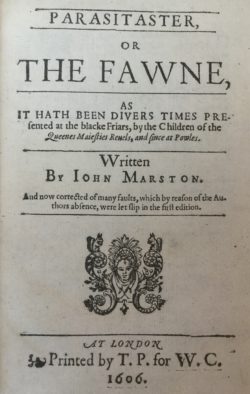<em>The Fawn</em>
Reader, know I have perused this coppy, to make some satisfaction for the first faulty impression: yet so urgent hath been my business, that some errors have styll passed, which thy discretion amend. Comedies are writ to be spoken, not read: remember the life of these things consists in action.
Tucked at the bottom of a page underneath the address ‘To My Equal Reader’ at the front of the second quarto of Marston’s The Fawn, these words seem to come directly from the author himself. They appear to urge us not to rely on the printed text in front of us but to trust instead to the ‘discretion’ of readers and the collaborative energies of theatrical performance. Both quartos of The Fawn were printed close together in 1606. Though editors now focus as much on printing house and playhouse practice as on seeking out the text closest to the author’s hand, the implication seems to be that Marston himself – albeit patchily – corrected this second printing. Yet much of that second printing is in fact very closely based on the first. This, then, is a moment when author and print seem to combine; strikingly, though, it illuminates the skilful but unreliable collaboration between author, compositor and printing house that goes to make a printed playtext. So, even at a moment when Marston as author seems to assert his authority over that of the printing house, we are given a glimpse of the unstable processes of textual creation.
Originally titled Parasitaster, or the Fawn and probably written sometime in 1604, the play was performed by at least two children’s companies. The title page for Q1 declares that Marston’s play was performed by at the Blackfriars by the ‘Children of the Queenes Maiesties Reuels’, the company patronised by Queen Anna of Denmark. The title page of Q2 then adds ‘and since at Powles’ (i.e. the boys’ company at St. Pauls). The play's alternative Latinized name means a flatterer or hanger-on, and both titles signal the play’s attack on courtly flattery, insinuation and social climbing in the years after Elizabeth I’s death and during the establishment of the Jacobean court. Indeed, alongside plays by Shakespeare and Middleton, The Fawn is an early Jacobean disguised ruler play. It dramatizes a struggle between folly and maturity, at first by concentrating on the foolishness of desire in the old. Hercules, the old Duke of Ferrara, arranges a match with Dulcimel, the youthful daughter of his counterpart in Urbino. This, however, is a ruse to allow him to put his reluctant son Tiberio in Dulcimel’s way in order to instigate a more appropriate marriage between the two younger characters. The Duke, meanwhile, has travelled to Urbino disguised as the eponymous ‘Faunus’ to monitor his son’s progress and observe and correct the corruption of the flatters and insinuators who people the court. The denouement, fittingly, is a satirical courtly entertainment, a Cupid’s Parliament, during which the courtiers are punished one by one for their vice and committed to a Ship of Fools.
Marston’s interest in witty, performative and active women is clear in The Fawn. The Duke’s marriage scheme works, but it owes more to Dulcimel’s wit and careful managing of the men around her than it does to any spark of initiative from Tiberio. Marston reworks a tale from Day 3 of Boccaccio’s Decameron, having the witty Dulcimel use a friar as an unwitting intermediary, duping him into returning an unsent gift and into instructing her suitor how to get into her chamber unseen by climbing a tree. This elite woman navigates obstacles to achieve a measure of self-determination within the confines of the heterosexual romance plot.
Strikingly, the seventeenth-century afterlife of The Fawn reveals the traces of the interconnected theatrical cultures of early modern England and Europe. English actors mounted a play with striking similarities near Nuremberg in 1604, and The Fawn itself – or a version of it – may also have been played in Dresden by another English company in summer 1616. The Fawn, then, is a play that travels beyond London and beyond the circumstances of its initial composition. The relationship between this group of plays is tough to unravel (June Schlueter calls these adaptations or appropriations ‘look-alikes’). But, whether one play derived directly from another, whether they came from a shared original (now lost), or whether they are examples of dramatists taking up materials from a shared stock of plots, scenarios and set-pieces, the lives of The Fawn and its close relations in early modern England and northern Europe extend its reach beyond the purely local.

